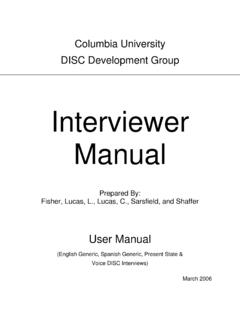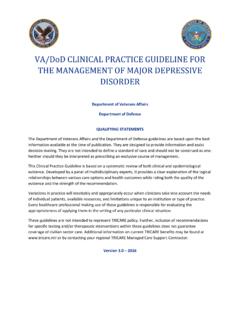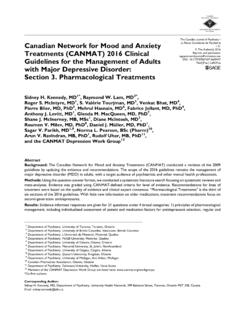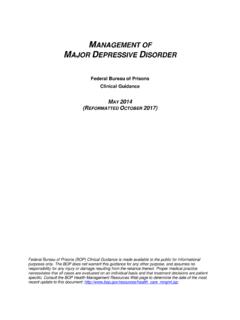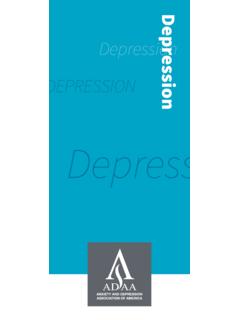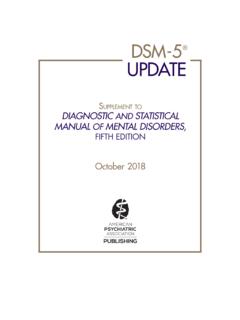Transcription of DSM-5 Criteria: Major Depressive Disorder
1 Page 30 Criteria: Major Depressive DisorderMajor Depressive episode : FFive (or more) of the following symptoms have been present during the same 2-week period and represent a change from previous functioning; at least one of the symptoms is either (1) depressed mood or (2) loss of interest or pleasure. Note: Do not include symptoms that are clearly attributable to another medical condition. Depressed most of the day, nearly every day as indicated by subjective report ( , feels sad, empty, hopeless) or observation made by others ( , appears tearful) Markedly diminished interest or pleasure in all, or almost all, activities most of the day, nearly every day (as indicated by subjective account or observation) Significant weight loss when not dieting or weight gain ( , change of more than 5% of body weight in a month), or decrease or increase in appetite nearly every day Insomnia or hypersomnia nearly every day Psychomotor agitation or retardation nearly every day (observable by others, not merely subjective feelings of restlessness or being slowed down)
2 Fatigue or loss of energy nearly every day Feelings of worthlessness or excessive or inappropriate guilt (which may be delusional) nearly every day (not merely self-reproach or guilt about being sick). Diminished ability to think or concentrate, or indecisiveness, nearly every day (either by subjective account or as observed by others) Recurrent thoughts of death (not just fear of dying), recurrent suicidal ideation without a specific plan, or a suicide attempt or a specific plan for committing suicide FThe symptoms cause clinically significant distress or impairment in social, occupational, or other important areas of functioning. FThe episode is not attributable to the physiological effects of a substance or to another medical : The above criteria represent a Major Depressive episode .
3 FThe occurrence of the Major Depressive episode is not better explained by schizoaffective Disorder , schizophrenia, schizophreniform Disorder , delusional Disorder , or other specified and unspecified schizophrenia spectrum and other psychotic disorders. FThere has never been a manic episode or a hypomanic episode . Note: This exclusion does not apply if all of the manic-like or hypomanic-like episodes are substance-induced or are attributable to the physiological effects of another medical 4. DSM-5 Diagnosis: Major Depressive DisorderPa g e 31 of Major Depressive DisorderNote: Treatment recommendations are based on levels of evidence and expert opinion. For a description of the criteria for each level, see page 4. Conduct comprehensive assessment and use measurement-based care.
4 Refer to Principles of Practice on pages 6 therapeutic objectives of acute treatment are to assure safety, measure response to therapy, provide psychoeducation to patient and circle of care, and to begin the process of symptomatic, syndromal, and functional recommend psychiatric consultation prior to initiation of therapy + psychotherapeutic medication using a multi-disciplinary approach if treated by a for: nCurrent/Prior hypomania/mania, symptoms/episodes* nPsychiatric and medical comorbidities ( , substance-related disorders, anxiety disorders, obesity, diabetes) nPresence of specifiers, notably: psychosis, mixed features, suicidality nPresence of cognitive dysfunction ( , memory complaints; difficulty with concentration, making decisions, and thinking clearly) nAssess for recurrence vulnerability factors ( , symptom severity, age of onset, number of Depressive episodes) nManual-based psychotherapy ( , CBT) or exercise therapy may be an appropriate treatment option for mild depression ( , PHQ-9 score 5 through 9).
5 *Note: Rule out the possibility of bipolar Disorder in individuals presenting with Depressive 1 Initial Treatment: FAntidepressant Monotherapy trial at adequate dose and evaluate*: Selective serotonin reuptake inhibitor (SSRI)**, serotonin-norepinephrine reuptake inhibitor (SNRI), or vortioxetine Bupropion or mirtazapine FIf partial response at 2 to 4 weeks, may continue for another 2 to 4 weeks or go to Level 2. FIf no response at 4 weeks, ensure dose optimization and go to Level :*Medication response is more pronounced in moderate to severe depression.**Consider propensity for drug-drug interactions and differential risk for combination therapy for individuals with recurrent depression, persistent Depressive Disorder , and history of trauma. Be vigilant of emergence of hypomanic symptoms.
6 Page 32 Treatment of Major Depressive Disorder (continued)Level 2 If Level 1 is ineffective and/or not well tolerated: FEvaluate adherence FEnsure dose optimization of medication used in Level 1. FSwitch to different monotherapy agent from different or same class (SSRI, SNRI, bupropion, or mirtazapine). FCombine existing monotherapy with: Evidence-based psychotherapy ( , CBT, IPT) Second-generation antipsychotic FDA-approved for augmentation therapy for Major Depressive Disorder (MDD) ( , aripiprazole or brexpiprazole; quetiapine is level 3 due to tolerability concerns) Intranasal esketamine or intravenous racemic ketamine. In the case of intranasal esketamine, co-administration with a separate antidepressant. An antidepressant (avoid SSRI and SSRI/SNRI combinations) Note: FDA-approved adjunctive agents for MDD are select atypical antipsychotics.
7 Preliminary evidence evaluating comparative effectiveness of adjunctive antidepressant versus adjunctive atypical antipsychotic medications indicates superior efficacy for adjunctive antipsychotics and superior tolerability for adjunctive 3 If Levels 1 and 2 are ineffective and/or not well tolerated: FEvaluate adherence FSeek psychiatric consultation F(SSRI or SNRI) + quetiapine (tolerability concerns) F(SSRI or SNRI) + (lithium or T3) F(SSRI or SNRI) + (L-Methylfolate or S-adenosylomethionine) FTricyclic antidepressant (TCA) FMonoamine oxidase inhibitor (MAOI) FElectroconvulsive therapy (ECT) FTranscranial magnetic stimulation (TMS)**Note: Most evidence for TMS is in the acute 4 If Levels 1 3 are ineffective and/or not well tolerated: FRe-evaluate diagnosis if patient has failed to respond to 2 or more treatments FMonoamine oxidase inhibitor (MAOI) augmentation (AVOID CONTRAINDICATED COMBINATIONS) FL-methylfolate augmentation FTriple drug combination (little evidence exists supporting or refuting this strategy) (SSRI or SNRI) + mirtazapine + bupropion (SSRI or SNRI) + mirtazapine + lithium* (SSRI or SNRI) + bupropion + second generation antipsychotic (SGA) FOther neuromodulatory approaches [ , vagus nerve stimulation (VNS)]*Note: Caution should be used when prescribing lithium due to increased risk to the fetus with use during pregnancy ( , Ebstein s anomaly).
8 Page 33 Treatment of Major Depressive Disorder with Mixed FeaturesNote: Treatment recommendations are based on levels of evidence and expert opinion. For a description of the criteria for each level, see page 4. Conduct comprehensive assessment and use measurement-based care. Refer to Principles of Practice on pages 6 features are subsyndromal hypomanic features defined according to the Diagnostic and Statistical Manual of Mental Disorders, Fifth Edition ( DSM-5 ).Strongly recommend psychiatric consultation prior to initiation of therapy + psychotherapeutic medication using a multi-disciplinary approach if treated by a for: nPrior history of hypomania/mania nPsychiatric and medical comorbidities ( , substance use disorders, anxiety disorders, obesity, diabetes) Level 1 Initial Treatment.
9 FMinimal evidence for treating Major Depressive order (MDD) with mixed features specifier FDiscuss treatment option, including evidence-based psychotherapy [Cognitive Behavioral Therapy (CBT), Interpersonal Psychotherapy (IPT), Behavioral Activation] FConsider FDA-approved second generation antipsychotic (SGA)** for augmentation in MDD or mood stabilizer ( , lithium*) FAntidepressant monotherapy 4 to 8 week trial at adequate dose and evaluate Selective serotonin reuptake inhibitor (SSRI), serotonin-norepinephrine reuptake inhibitor (SNRI), or vortioxetine Bupropion (if tolerability concerns) or mirtazapineNote: Antidepressant monotherapy in MDD with subsyndromal hypomania may be associated with a higher rate of suboptimal therapeutic outcomes when compared to MDD without subsyndromal hypomania.
10 FFor all Level 1 treatments, if partial response at 4 weeks, may continue for another 2 to 4 weeks or go to Level 2. FFor all Level 1 treatments, if no response at 4 weeks, ensure dose optimization and go to Level 2 If Level 1 is ineffective and/or not well tolerated: FReassess for hypomania/mania FEnsure dose optimization of medication used in Level 1 FSwitch to lurasidone monotherapy or adjunctPage 34 of Major Depressive Disorder with Mixed Features (continued)Level 3 If Levels 1 and 2 are ineffective and/or not well tolerated: FAlternative adjunctive SGA or lithium or lamotrigine FConsider electroconvulsive therapy (ECT) or transcranial magnetic stimulation (TMS) FAlternative antidepressants, including tricyclic antidepressant (TCA), monoamine oxidase inhibitor (MAOI), or first generation antipsychotic (FGA)**Notes.

